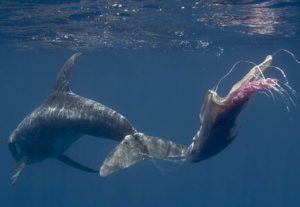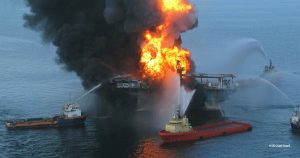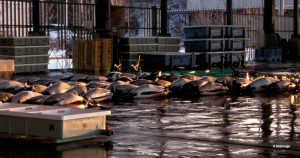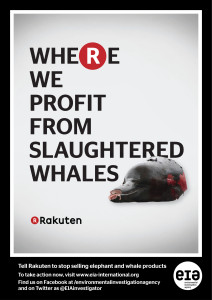Highlighting the threats to whales, dolphins and porpoises
Since the moratorium on commercial whaling was agreed, the intensification of human activities has wrought unprecedented changes on the marine environment upon which cetaceans depend.
The world’s oceans are in an increasingly fragile state and there now exists even greater cause for concern – and doubt about the ability of cetacean populations to withstand direct hunting – than ever before. There is a pressing need to better protect cetacean populations from anthropogenic threats to allow them a fighting chance in the face of unprecedented environmental changes.
At such a time, the role of the moratorium in protecting cetacean populations from direct commercial hunting has never been so important.
Our 2016 report Plight of the Ocean Sentinels outlines the major environmental activities that threaten the survival of the great whales and their cetacean cousins – dolphins and porpoises.
Climate change
Ocean changes due to climate change are likely to pose one of the greatest threats to cetacean populations, through ocean acidification, melting of ice sheets, changes in ocean temperature, disruption of food chains and changes in the supply and cycling of nutrients.
 Marine debris
Marine debris
Plastics form the vast majority of marine debris, from packaging-related litter, fishing lines and nets to microplastics and nanoplastics. The equivalent of a full rubbish truck of plastic waste is dumped into the ocean every minute. Plastic pollution poses a serious threat to cetaceans when they ingest plastic waste or become entangled in plastic including abandoned fishing gear.
Read Report: Dying at our convenience
Chemical pollution
Polychlorinated biphenyls (PCBs) are chemicals that were used in plastics, paints and electrical equipment. Although they were banned in the 1970s, they have created a toxic legacy for certain toothed cetaceans, particularly killer whales, striped and bottlenose dolphins and harbour porpoises. They are known to cause immunosuppression and to impair reproduction and are likely to affect cetacean populations in Europe for decades to come.

The Deepwater Horizon oil spill of 2010 had a disastrous impact on cetaceans. This was the largest spill in marine oil drilling history involving a BP rig in the Gulf of Mexico which exploded and sank with four million barrels of oil being released over more than 80 days until it was finally capped. Evidence suggests there was up to a 51 per cent reduction in the dolphin population in the local area.
Bycatch
Bycatch – the process whereby marine species are caught unintentionally – is one of the primary direct threats to whales, dolphins and porpoises worldwide. The vaquita will be extinct within a few years unless bycatch in gillnets is completely eliminated from its habitat in the Upper Gulf of California, Mexico.
Other cetaceans threatened by bycatch include: populations of harbour porpoise in the Baltic Sea and the Black Sea; the franciscana, dusky dolphins, Chilean dolphins and Commerson’s dolphins in South America; Hector’s dolphins in New Zealand; J-stock minke whales in Japan and South Korea; Indo-Pacific and humpback dolphins off the coast of South Africa and Tanzania; common and striped dolphins in Peru, Ecuador and the Mediterranean; North Atlantic right whales off the east coast of the US; sperm whales in the Mediterranean; and populations of finless porpoises and river dolphin species in Asia.
The U.S. Marine Mammal Protection Act (MMPA) requires the U.S. government to ban seafood from nations that fail to meet the same strict standards to prevent marine mammal bycatch that U.S. fishers must meet. But the National Marine Fisheries Service (NMFS) recently delayed any decision on blocking imports from non-compliant nations until 2025, risking the future of cetacean populations globally.
Other cetaceans threatened by bycatch include: populations of harbour porpoise in the Baltic Sea and the Black Sea; the franciscana, dusky dolphins, Chilean dolphins and Commerson’s dolphins in South America; Hector’s dolphins in New Zealand; J-stock minke whales in Japan and South Korea; Indo-Pacific and Atlantic humpback dolphins off the coasts of Africa; common and striped dolphins in Peru, Ecuador and the Mediterranean; North Atlantic right whales off the east coast of the US; sperm whales in the Mediterranean; and populations of finless porpoises and river dolphin species in Asia.
Noise pollution
Cetaceans live in a world of sound, using acoustics to perform vital activities in their life cycle including communication, mating behaviours, navigation and locating prey and predators. As the quantity and level of anthropogenic sound increases in our ocean, so the ability of cetaceans to perform these key tasks is affected, with impacts ranging from chronic stress, deafness, increased energy expenditure, habitat displacement and reduced communication range through to mortality.
Key sources of noise pollution include sonar, seismic surveys and shipping as well as pile-driving, drilling and dredging.




 Marine debris
Marine debris


